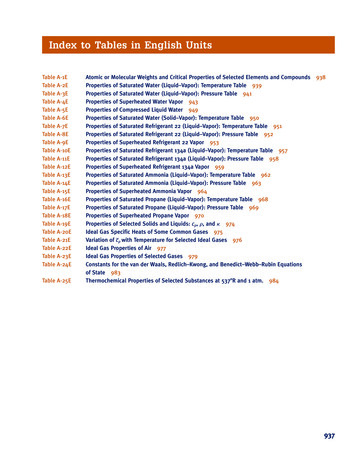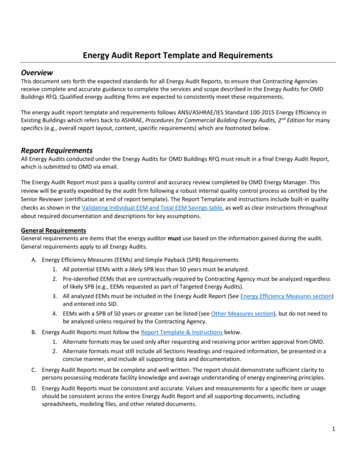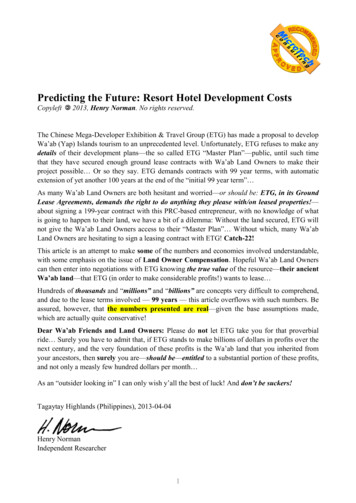
Transcription
Table of Contents – Part IIAlta Colleges, Inc. (19,190 students, based in Denver, CO) .201American Career Colleges, Inc. (4,761 students, based in Irvine, CA) .227American Public Education (77,000 students, based in Charlestown, WV) .240Anthem Education Group (12,792 students, based in Phoenix, AZ) .254Apollo Group, Inc. (470,800 students, based in Phoenix, AZ) .272Bridgepoint Education, Inc. (77,179 students, based in San Diego, CA) .294Capella Education Company (38,634 students, based in Minneapolis, MN) .316Career Education Corporation (118,205 students, based in Schaumburg, IL) .331Chancellor University LLC (739 students, based in Seven Hills, OH) .355Concorde Career Colleges, Inc. (7,952 students, based in Kansas City, MO) .365Corinthian Colleges, Inc. (113,818 students, based in Santa Ana, CA) .379DeVry, Inc. (130,375 students, based in Downers Grove, IL) .402ECPI Colleges, Inc. (13,119 students, based in Virginia Beach, VA) .421Education America, Inc. (10,018 students, based in Heathrow, FL) .436Education Management Corporation (158,300 students, based in Pittsburg, PA).450Grand Canyon Education, Inc. (42,300 students, based in Phoenix, AZ) .475Henley Putnam University (515 students, based in San Jose, CA) .491Herzing, Inc. (8,253 students, based in Milwaukee, WI) .499ITT Educational Services, Inc. (88,004 students, based in Carmel, IN) .516Kaplan Higher Education Corporation (112,141 students, New York City, NY) .544The Keiser School, Inc. (18,956 students, based in Fort Lauderdale, FL).570Lincoln Education Services Company (33,175 students, based in West Orange, NJ) .585Med-Com Career Training / Drake College (2,692 students, based in Elizabeth, NJ) .602National American University Holdings, Inc. (8,255 students, based in Rapid City, SD) .614Rasmussen Colleges, Inc. (17,090 students, based in Minnetonka, MN) .633Strayer Education, Inc. (60,711 students, based in Arlington, VA) .651TUI Learning LLC (7,307 students, based in Cypress, CA) .666Universal Technical Institute, Inc. (21,000 students, based in Scottsdale, AZ) .675Vatterott Education Holdings, Inc. (11,163 students, based in St. Louis, MO) .690Walden, LLC (47,456 students, based in Minneapolis, MN).707
Alta Colleges, Inc.IntroductionAlta Colleges, Inc. (“Alta”) is a medium-sized privately held for-profit education company and isone of the most expensive schools examined by the committee. Like many for-profit educationcompanies, Alta has experienced significant growth in student enrollment, Federal funds collected, andprofit realized in recent years. While the company’s performance, measured by student withdrawal isbetter than many companies examined, default rates are higher than most.Witness testimony, investigations by the Department of Education and Colorado attorneygeneral, and internal company documents indicate that the company aggressively recruited students withsometimes misleading and deceptive tactics. It is unclear whether the Federal investment taxpayers aremaking in the company should go to support these practices.Company OverviewAlta is a privately held for-profit education company based in Denver, CO. The company isprincipally owned by a Boston private equity firm, Housatonic Partners. Alta Colleges operates 18campuses under the Westwood Colleges brand, including an online campus, and one campus under theRedstone College brand.777 Three of those campuses, all in Texas, suspended enrolling new students inlate 2011 following actions by the Texas Workforce Commission, the State agency with jurisdictionover the campuses, and by the Veterans Administration, which oversees the educational benefits ofstudent veterans attending those campuses.Alta Colleges, Inc. was founded in 1953 in Denver, CO. Originally known as the Radio andTelevision Repair Institute, the school’s identity underwent several significant transformations since itsfounding.778 The school changed its name to the National Electronics Institute (NEI) in 1958, as itadapted and expanded the curriculum.779 NEI was acquired by the Denver Institute of Technology, Inc.in 1974, which was in turn acquired by the founders of Alta in 1987.780 In 1997, Denver Institute ofTechnology changed its name to Westwood College. Housatonic partners became a shareholder in2002.The company’s Westwood College brand offers Certificate programs and Associate, Bachelor’s,and Master’s degree programs across a range of disciplines, including information technology, businessadministration, criminal justice, design, and medical assisting, among other subjects. The largestprograms by enrollment are: criminal justice (31 percent), design (28 percent) and informationtechnology (18 percent).781 Westwood College campuses are nationally accredited by the Accrediting777Westwood College, Inc. is a holding company through which Alta owns five smaller corporations that in turn own andoperate 18 Westwood College campuses. Redstone College is operated through Alta Colleges, Inc.’s Paris ManagementCorporation subsidiary.778See Westwood College, 2012 Academic Catalog: California/Colorado/Georgia/Virginia (2011).779See id.780See Terry Wilson, “Riedinger, Turner head the class with Alta College,” Denver Business Journal , June 23, 2/06/24/focus1.html?page all (accessed June 6, 2012).781Alta, February 2010, Program Portfolio Review (HELP-ALTA-000167).202
Council for Independent Colleges and Schools (ACICS). Approximately 26 percent of its students areenrolled in online programs.The current president and chief executive officer of Alta is Dean Gouin. George Burnett, whoformerly served in management positions at Qwest Communications, stepped down as CEO in late 2011following a number of problems involving the college’s accreditation and certification as well aslawsuits brought by former students.782 Eric Goodman, Alta’s Chief Academic Officer, also left andmoved to ECPI University, a Virginia-based for-profit education company.783 He was replaced by JohnKeim.Enrollment at Alta Colleges, Inc. Colleges, Fall 2001 Fall 2002 Fall 2003 Fall 2004 Fall 2005 Fall 2006 Fall 2007 Fall 2008 Fall 2009 Fall 2010Alta’s enrollment more than quadrupled in 10 years, growing from approximately 4,300 studentsat the end of 2001 to 19,190 in 2010.784 This growth in enrollment led to growth in revenue. Revenue atAlta grew steadily from approximately 269 million in 2006 to 380 million in 2009.785782Business Briefs, “Chief of Alta Colleges tenders resignation,” Denver Post, September 27, 2011.http://www.denverpost.com/business/ci 18983399 (accessed June 13, 2012).783Eric Goodman, LinkedIn profile. http://www.linkedin.com/pub/eric-goodman/1/699/b0a (accessed May 23, 2012).784Enrollment is calculated using fall enrollment for all unit identifications controlled by the company for each year from theDepartment of Education ’s Integrated Postsecondary Data System (hereinafter IPEDS). See Appendix 7. The most currentenrollment data from the Department of Education measures enrollment in fall 2010. In 2011 and 2012, news accounts andSEC filings indicated that many for-profit education companies experienced a drop in new student enrollment. This has alsoled to a decrease in revenue and profit at some companies.785See Deloitte & Touche LLP, Alta Colleges, Inc. and Subsidiaries, Consolidated Financial Statements as of and for theYears Ended September 30, 2009 and 2008, Supplemental Schedules as of and for the Years Ended September 30, 2009 and2008, and Independent Auditor’s Report 6,2009 (on file with committee). Revenue figures for publicly traded companies are203
Federal RevenueNearly all for-profit education companies derive the majority of their revenue from Federalfinancial aid programs. Between 2001 and 2010, the share of title IV Federal financial aid fundsflowing to for-profit colleges increased from 12.2 to 24.8 percent and from 5.4 to 32.2 billion.786Together, the 30 companies the committee examined derived 79 percent of their revenue from title IVFederal financial aid programs in 2010, up from 69 percent in 2006.787In 2010, Alta reported 83.9 percent of revenue from title IV Federal financial aidprograms.788 However, this amount does not include revenue received from the Departments of Defenseand Veterans Affairs education programs or revenue the company was allowed to temporarily discountpursuant to the Ensuring Continued Access to Student Loans Act (ECASLA).789 The committeeestimates that Alta discounted approximately 6.4 percent of revenue, or 24.5 million, pursuant toECASLA. Department of Defense Tuition Assistance and post-9/11 GI bill funds accounted forapproximately 4.6 percentof Alta’s revenue, or 17.5 million.790 With funds from the Departments of Defense and VeteransAffairs included, 88.5 percent of Alta’s total revenue was comprised of Federal education funds.791from Securities and Exchange Commission annual 10-K filings. Revenue figures for privately held companies are takenfrom the company financial statements produced to the committee. See Appendix 18.786“Federal financial aid funds” as used in this report means funds made available through Title IV of the Higher EducationAct, including subsidized and unsubsidized Stafford loans, Pell grants, PLUS loans and multiple other small loan and grantprograms. See 20 U.S.C. §1070 et seq. Senate HELP Committee staff analysis of U.S. Department of Education, FederalStudent Aid Data Center, Title IV Program Volume Reports by programmatic.html, 2001-2 and 2010-11. Figures for 2000-1 calculated using dataprovided to the committee by the U.S. Department of Education.787Senate HELP Committee staff analysis of Proprietary School 90/10 numerator and denominator figures for each OPEIDprovided to the U.S. Department of Education pursuant to section 487(d)(4) of the Higher Education Act of 1965. Data forfiscal year 2006 provided to the committee by each company; data for fiscal year 2010 provided by the Department ofEducation on October 14, 2011. See Appendix 9.788Senate HELP Committee staff analysis of fiscal year 2010 Proprietary School 90/10 numerator and denominator figuresfor each OPEID provided to the U.S. Department of Education pursuant to section 487(d)(4) of the Higher Education Act of1965. Data provided by the Department of Education on October 14, 2011. See Appendix 9.789The Ensuring Continued Access to Student Loan Act (ECASLA) increased Stafford loan amounts by up to 2,000 perstudent. The bill also allowed for-profit education companies to exclude the increased amounts of loan eligibility from thecalculation of Federal revenues (the 90/10 calculation) during fiscal years 2009 and 2010.790Post-9/11 GI bill disbursements for August 1, 2009-July 31, 2010 provided to the committee from the Department ofVeterans Affairs on November 5, 2010; post-9/11 GI bill disbursements for August 1, 2009 June 15, 2011 provided to thecommittee from the Senate Committee on Veterans’ Affairs via the Department of Veterans Affairs on July 18, 2011;Department of Defense Tuition Assistance disbursements and MyCAA disbursements for fiscal years 2009-11 provided (bybranch) by the Department of Defense on December 19, 2011. Committee staff calculated the average monthly amount ofbenefits collected from VA and DOD for each company, and estimated the amount of benefits received during the company’s2010 fiscal year. See Appendix 11 and 12.791See Appendix 10.204
Alta Colleges, Inc. Federal Money Share, 2010Federal EducationFunds: 338 Million11.5%88.5%Federal Education FundsNon‐Federal FundsOver the past 10 years, the amount of Pell grant funds collected by for-profit colleges as a wholeincreased from 1.4 billion to 8.8 billion; the share of total Pell disbursements that for-profit collegescollected increased from 14 to 25 percent.792Part of the reason for this increase is that Congress has repeatedly increased the amount of Pellgrant dollars available to a student over the past 4 years, and, for the 2009–10 and 2010–11 academicyears, allowed students attending year-round to receive two Pell awards in 1 year. Poor economicconditions have also played a role in increasing the number of Pell eligible students enrolling in forprofit colleges.792Senate HELP Committee staff analysis of U.S. Department of Education, Federal Student Aid Data Center, Title IV PellGrant Program Volume Reports by School, 2001-2 and /programmatic.html.205
Pell Grant Funds Collected by Alta Colleges, Inc.,Award Years 2007‐10100 889080Dollars In Millions706050 4640 3330 25201002007200820092010Alta more than tripled the amount of Pell grant funds it collected, from 25.4 million in 2007 to 87.6 million in 2010.793 Internal company documents reviewed by the committee indicate that Altaexecutives looked for ways to structure the colleges’ programs so that the company was able to collectas much Federal money as possible. A 2009 pricing strategy document recommended that the company“restructure terms to 3 trimesters/year or quarter time (so that we can grab more of the students’Stafford).” 794SpendingWhile the Federal student aid programs are intended to support educational opportunities forstudents, for-profit education companies direct much of the revenue derived from these programs tomarketing and recruiting new students, and to profit. On average, among the 15 publicly tradededucation companies, 86 percent of revenue came from Federal taxpayers in fiscal year 2009.795 Duringthe same period the companies spent 23 percent of revenue on marketing and recruiting ( 3.7 billion),793Pell disbursements are reported according to the Department of Education’s student aid “award year,” which runs fromJuly 1 through June 30 each year. Senate HELP Committee staff analysis of U.S. Department of Education, Federal StudentAid Data Center, Title IV Pell Grant Program Volume Reports by School, 2006-7 through /programmatic.html. See Appendix 13.794Alta, February 2009, Pricing Manager Business Case, (HELP-ALTA-000153, at HELP-ALTA-000159).795Senate HELP Committee staff analysis of fiscal year 2009 Proprietary School 90/10 numerator and denominator figuresplus all additional Federal revenues received in fiscal year 2009 provided to the committee by each company pursuant to thecommittee document request of August 5, 2010.206
and 19.7 percent on profit ( 3.2 billion).796 These 15 companies spent a total of 6.9 billion onmarketing, recruiting and profit in fiscal year 2009.797In 2009, Alta allocated 29.1 percent of its revenue, or 110.8 million, to marketing and recruitingand 8.5 percent, or 32.4 million, to profit.798Alta Colleges, Inc. Spending, 2009Marketing, 29.1%Other, 62.4%Profit, 8.5%The company posted an operating loss of about 1.8 million in 2007 before posting a profit of 19.1 million in 2008, growing to 32.4 million in 2009.799796Senate HELP Committee staff analysis of fiscal year 2009 financial statements (on file with committee). Marketing andrecruiting includes all spending on marketing, advertising, admissions and enrollment personnel. Profit figures representoperating income before tax and other non-operating expenses including depreciation. See Appendix 19.797Id.798The “other” category includes administration, instruction, executive compensation, student services, physical plant,maintenance and other expenditures. On average, the 30 for-profit schools examined spent 22.7 percent of revenue onmarketing and 19.4 percent on profit.799Senate HELP Committee staff analysis. See Appendix 18.207
Alta Colleges, Inc. Profit (Operating Income), 2006‐935 3230Dollars in Millions25 19201510 85‐ 1.80‐52006200720082009A former Westwood instructor, who filed a lawsuit against Westwood that was unsealed in late2011, wrote to Chairman Harkin expressing her concern with the way that the school was run; shewrote, “It is my opinion that this system is similar to a pyramid scheme in that it has allowed theshareholders at the top to profit greatly at the expense of others.” 800 The money the company spends onmarketing and recruiting pays for the salaries of its recruiters, as well as advertising space and “leads”from third-party telemarketing and internet firms. Alta’s “Book of Operations” notes that the company“utilizes an aggressive marketing plan to produce media leads [contacts of prospective students] from avariety of sources including television and internet.” 801Executive CompensationAs a privately held company, Alta is not obligated to release executive compensation figures.Tuition and Other Academic ChargesCompared to public colleges offering the same programs, the price of tuition is higher at Alta’scampuses. A Bachelor’s Degree in business administration costs 80,466.802 The same degree at the800Letter from Patti Howard to Senator Harkin, February 22, 2012. (After her tenure at Westwood, Ms. Howard filed alawsuit against Westwood stemming from allegations that the company had engaged in fraud.)801Alta, February 2009, Admissions Support Book of Operations (WP000036541, at WP000036576).802See Appendix 14; see also, Westwood College, Tuition Information for atalogs/D6485b CO Addendum.pdf (accessed June 12, 2012).208
University of Colorado at Boulder costs approximately 60,704.803 An Associate degree in informationtechnology at Westwood costs 48,194804, while the same degree at the Community College of Denvercost 8,823.805Cost of a Bachelor's Degree in Business Administration atWestwood College and University of Colorado 90,000 80,466 80,000 70,000 60,704 60,000 50,000 40,000 30,000 20,000 10,000 0Westwood CollegeUniversity of Colorado ‐ BoulderThe higher tuition that Alta charges is reflected in the amount of money that Alta collects foreach veteran that it enrolls. From 2009–11, Alta trained 1,894 veterans and received 34.8 million inpost-9/11 GI bill benefits, averaging 18,354 per veteran. In contrast, public colleges collected anaverage of 4,642 per veteran trained in the same period. 806Westwood is one of the most expensive for-profit colleges the committee examined. “Cost ofEducation” was the primary factor that led students to withdraw, according to responses to Alta’ssurveys of students who withdrew.807 Some “verbatim comments” made by surveyed students include,“Other schools offer the same courses that you do online and everything and are way cheaper than yourschool!” and “I found out that the tuition rate at Westwood was about 20,000.00 higher than othercolleges and/or universities. I'm sorry but I'm not going to pay 60,000.00 for a bachelor's degreethrough Westwood, when I can pay about 20,000.00 less at another school. What makes Westwood so803See Appendix 14; see also, University of Colorado Boulder,
Corinthian Colleges, Inc. . Alta Colleges, Inc. (“Alta”) is a medium-sized privately held for-profit education company and is . Alta Colleges, Inc. and Subsidiaries, Consolidated Financial Statements as of and for the Years Ended September 30, 2009 and 2008, Supplemental Schedules











